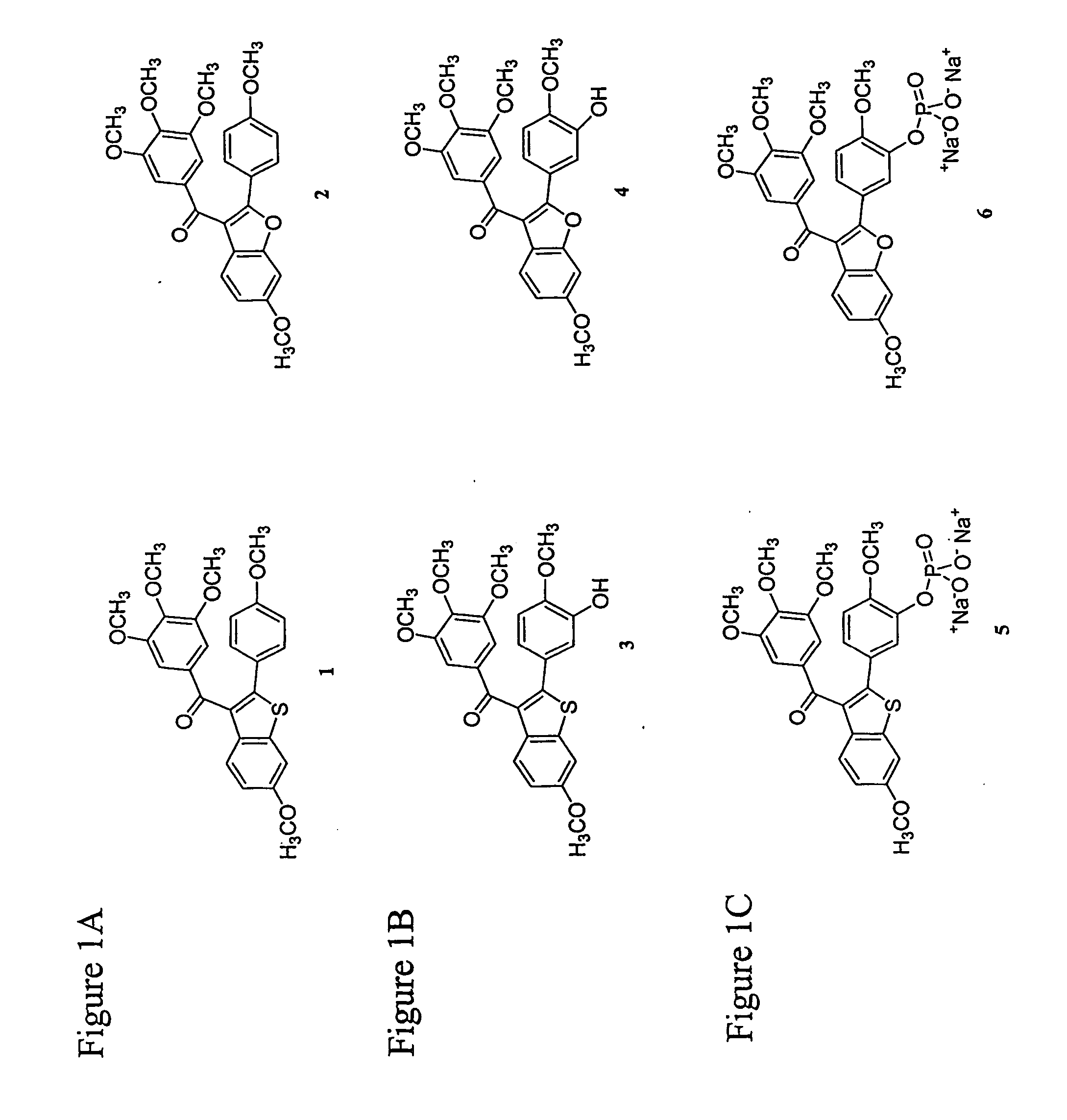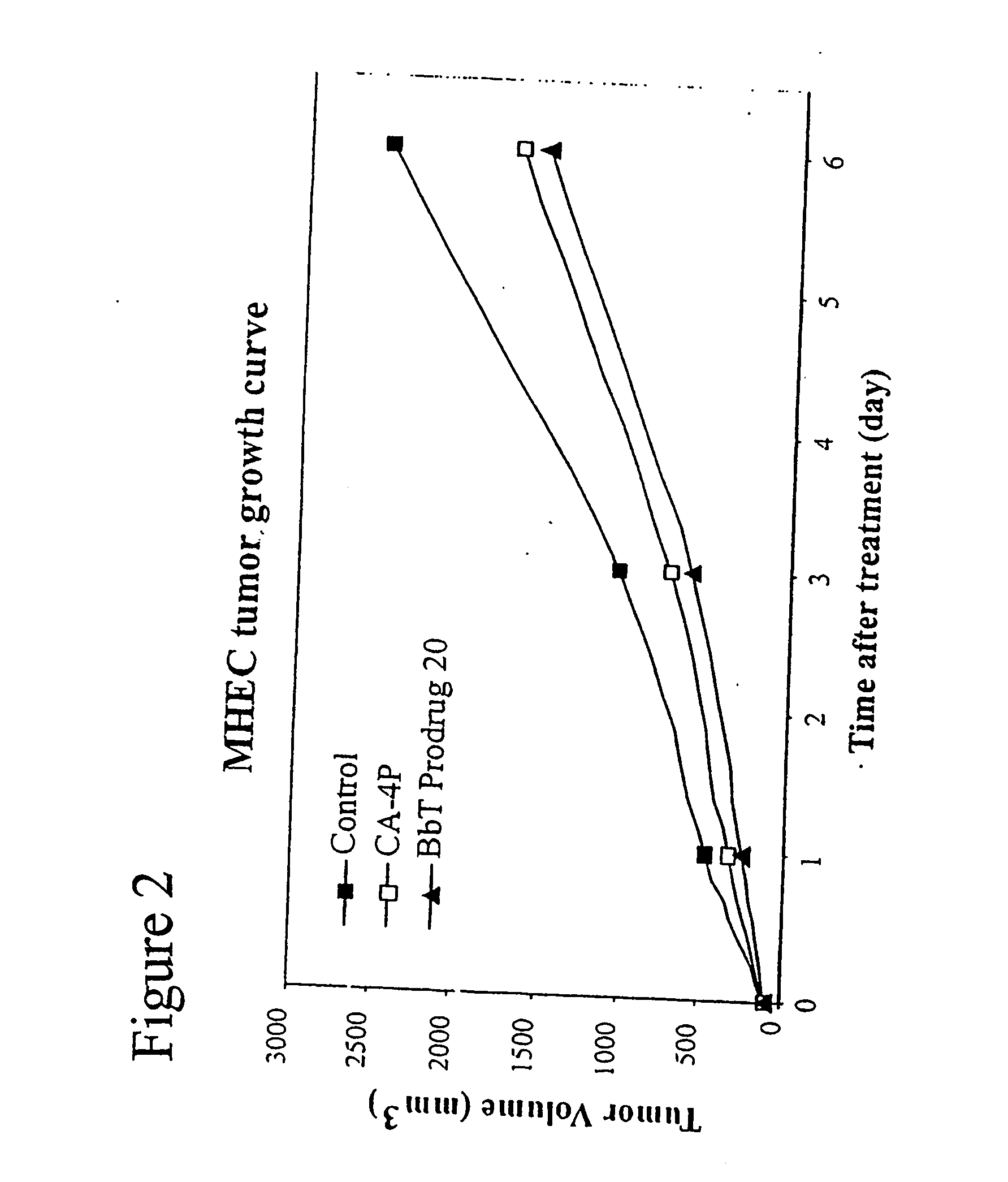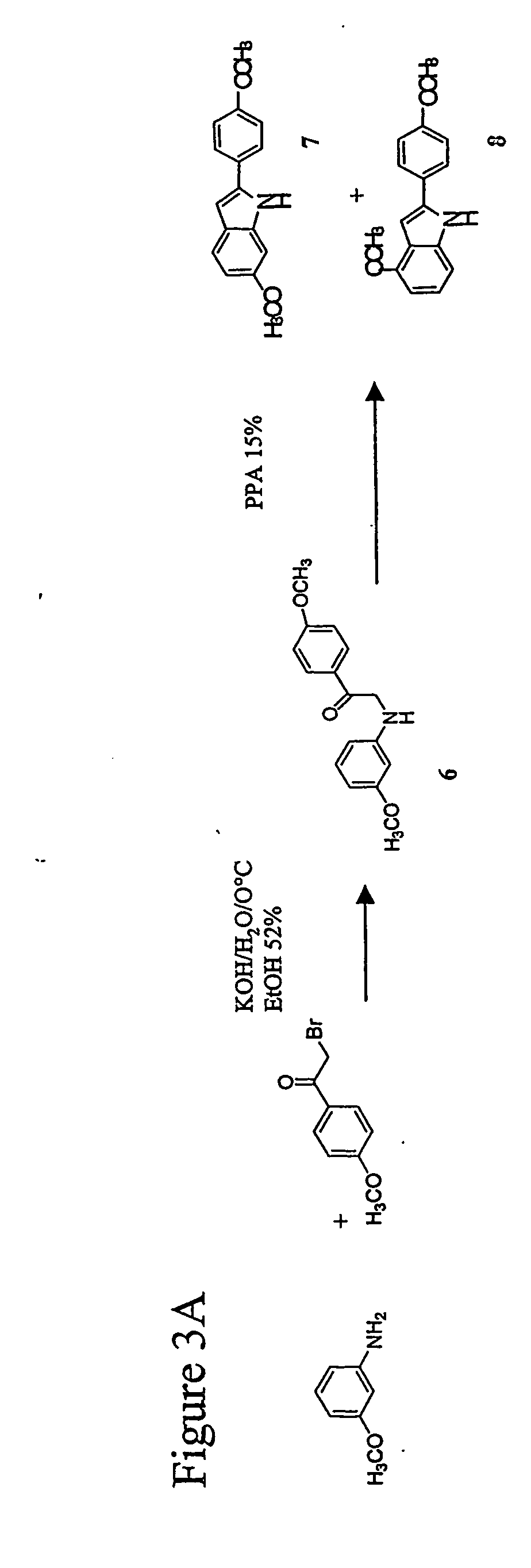Indole-containing compounds with anti-tubulin and vascular targeting activity
a technology of indole and vascular targeting, which is applied in the direction of biocide, group 5/15 element organic compounds, drug compositions, etc., can solve the problems of tumor necrosis and manifest substantial normal tissue toxicity, and achieve tumor necrosis, normal tumor blood flow, and tumor necrosis. the effect of necrosis
- Summary
- Abstract
- Description
- Claims
- Application Information
AI Technical Summary
Problems solved by technology
Method used
Image
Examples
example 1
Synthesis of 2-Aryl, 3-Aroyl Substituted Indole Tubulin Binding Agents
A) Synthesis of Phenylindoles
Method I (2 Steps):
Indole-based ligand 9 was synthesized as shown in FIGS. 3 and 4.
[0139] Secondary amine 6 was prepared by treatment of m-anisidine and 2-bromo-4-methoxyacetophenone under basic conditions (ethanolic potassium hydroxide) at 0° C. To a well-stirred solution of KOH (0.926 g, 16.5 mmol) in EtOH (18 ml) and H2O (9 ml) at R.T. was added m-anisidine (2.192 g, 17.80 mmol) by syringe. The solution was then stirred at 0° C. After 10 minutes, the solution of 2-bromo-4-methoxyacetophenone (4.09 g, 17.80 mmol) was added dropwise with an addition funnel over a 40 minute period. After 24 h, 0° C. to R.T., water was added. The product was isolated by extraction (1H HCl, NaHCO3, brine, MgSO4). The product was purified by recrystallization (50:50 EtOAc:hexanes) to afford secondary amine 6 (2.46 g, 9.07 mmol, 52%) as a yellow solid:
H NMR (CDCl3): δ7.98 (2H, d, J=8.9 Hz), 7.12 (...
example 2
Synthesis of Hydroxylated 2-Aryl, 3-Aroyl Substituted Indoles and Corresponding Phosphate Prodrugs
[0150] Based on promising results obtained with benzo[b]thiophene and benzofuran analogs, the preparation of hydroxylated indoles and corresponding phosphate salts was conducted as illustrated in FIG. 5.
A) Synthesis of Hydroxylated Bromoacetophenone
[0151] The synthesis of the target indole phosphate molecule involved the synthesis of a substituted bromoacetophenone 15 as a key intermediate, using commercially available isovanillin 10 (FIG. 4). After the protection of the phenol as silyl ether 11, addition of methyllithium gave the secondary alcohol 12 and this on oxidation with PCC gave the expected acetophenone derivative 13. Reaction of 13 with LDA, generated in situ, followed by addition of bromine resulted in the desired bromoacetophenone 15.
i) 3-tert-Butyldimethylsilyloxy-4-methoxybenzaldehyde (11)
[0152] To a well-stirred solution of 3-hydroxy-4-methoxybenzaldehyde 10 (15.26...
example 3
Synthesis of Amine Functionalized 2-Aryl, 3-Aroyl Substituted Indoles and Corresponding Phosphoramidate Prodrugs
[0173] In addition to the phosphate ester prodrugs that are described in this application for indole-based anti-mitotic agents, we have also discovered that phosphorous based prodrug derivatives of the nitrogenated indoles may have therapeutic advantages as selective tumor vasculature destruction agents. These compounds are primarily serinamides, phosphoramidates, and related phosphate dianions that are assembled on the amino substituent of tubulin binding indole analogs of CA4. When utilized iii vivo, phosphoramidate analogs are able to provide a more soluble compound than the corresponding amine, thereby increasing the bioavailability of the parent drug. The P—N bond can be enzymatically cleaved by serum phosphatases releasing the amine which can inhibit tubulin assembly in a manner analogous to CA4P.
[0174] The amine-based prodrugs of the invention can be synthesized a...
PUM
| Property | Measurement | Unit |
|---|---|---|
| chemical shift | aaaaa | aaaaa |
| chemical shift | aaaaa | aaaaa |
| chemical shift | aaaaa | aaaaa |
Abstract
Description
Claims
Application Information
 Login to View More
Login to View More - R&D
- Intellectual Property
- Life Sciences
- Materials
- Tech Scout
- Unparalleled Data Quality
- Higher Quality Content
- 60% Fewer Hallucinations
Browse by: Latest US Patents, China's latest patents, Technical Efficacy Thesaurus, Application Domain, Technology Topic, Popular Technical Reports.
© 2025 PatSnap. All rights reserved.Legal|Privacy policy|Modern Slavery Act Transparency Statement|Sitemap|About US| Contact US: help@patsnap.com



